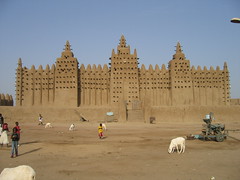Djenne is a small city near the River Niger in the nation of Mali. t is famous for its mud brick (adobe) architecture, most notably the Great Mosque of Djenné, originally built in 1220 and rebuilt in 1907. In the past, Djenné was a centre of trade and learning, says wikipedia.org.
Your teacher is reminded of the French city of Orleans. At only 100,000 people, it is half the size of Shreveport. But it has an enormous Gothic cathedral, the Cathédrale Sainte-Croix. Therefore it is a classic stop for people visiting France.
Djenne was once a base for the trans-Saharan trade. It rivalled Timbuktu, also a city built of mud structures.
Timbuktu is populated by Songhay, Tuareg, Fulani, and Mandé people, and is about 15 km north of the Niger River. It is also at the intersection of an east–west and a north–south Trans-Saharan trade route that crosses the Sahara. It was important historically (and still is today) as an entrepot for rock-salt.
Its geographical setting made it a natural meeting point for nearby African populations and nomadic Berber and Arab peoples from the north. Its long history as a trading outpost that linked west Africa with Berber, Arab, and Jewish traders throughout north Africa, and thereby indirectly with traders from Europe, has given it a fabled status. In the West it is a metaphor for exotic, distant lands: "from here to Timbuktu."
Timbuktu's long-lasting contribution to Islamic and world civilization is scholarship.[2] By the fourteenth century, important books were written and copied in Timbuktu, establishing the city as the centre of a significant written tradition in Africa
Subscribe to:
Post Comments (Atom)


No comments:
Post a Comment